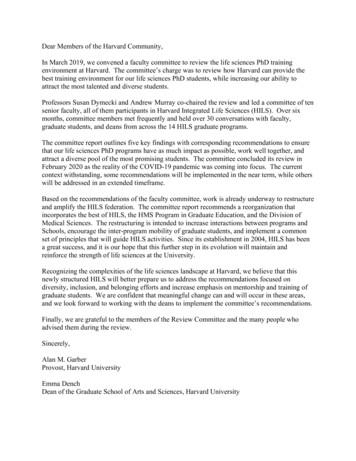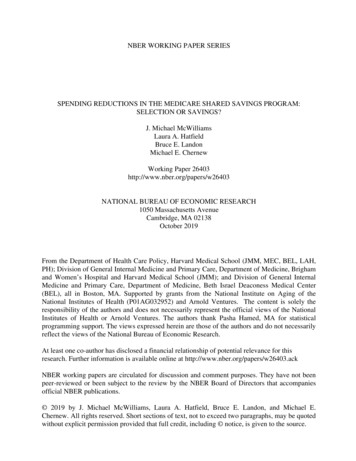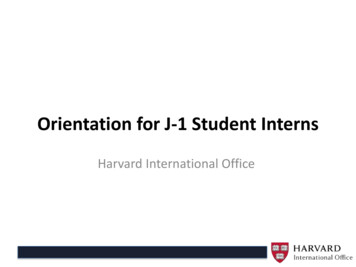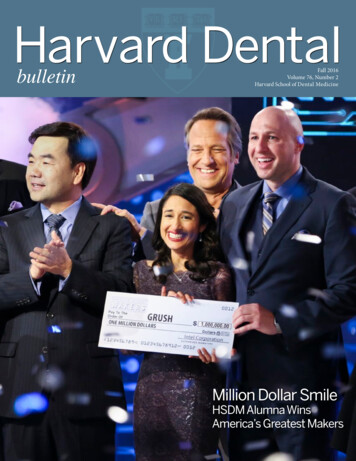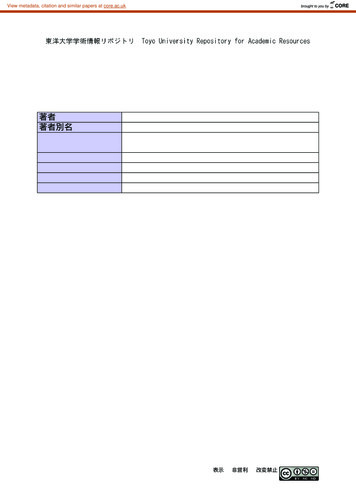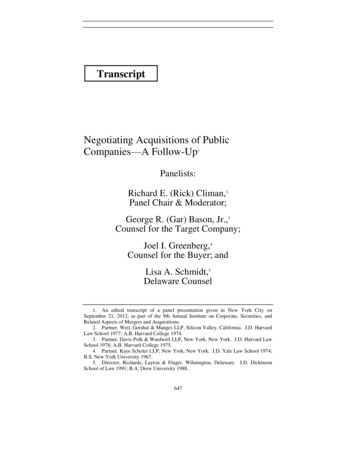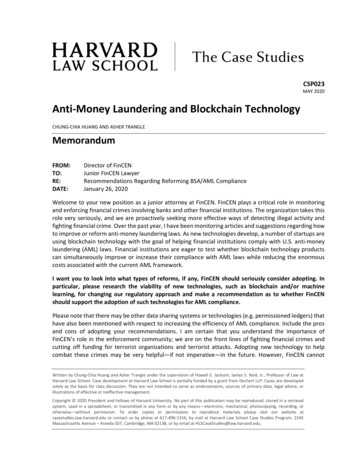
Transcription
Economic Analysis of LawLouis Kaplow and Steven Shavell*February 1999AbstractThis is a survey of the field of economic analysis of law, focusing on the work ofeconomists. The survey covers the three central areas of civil law — liability for accidents (tortlaw), property law, and contracts — as well as the litigation process and public enforcement oflaw.Forthcoming in A.J. Auerbach and M. Feldstein, Handbook of Public EconomicsJEL Classes K00, K10, K11, K12, K13, K14, K40, K41, K42, H23, L51*Harvard Law School and National Bureau of Economic Research. We thank Alan Auerbach, Steven Levitt, A.Mitchell Polinsky, and Tanguy van Ypersele for comments, Judson Berkey, Jerry Fang, and Chad Shirley for researchassistance, and the John M. Olin Center for Law, Economics, and Business at Harvard Law School for financial support.
Contents1.2.IntroductionLiability for Accidents2.1 Incentives2.2 Risk-bearing and Insurance2.3 Administrative Costs2.4 Magnitude of Liability: Damages2.5 Causation2.6 Judgment-Proof Problem2.7 Product Liability2.8 Liability versus Other Means of Controlling Accidents2.9 Intentional Torts3. Property Law3.1 Justifications for Property Rights3.2 Emergence of Property Rights3.3 Division and Form of Property Rights3.4 Public Property3.5 Acquisition and Transfer of Property3.6 Conflicts in the Use of Property: Externalities3.7 Property Rights in Information4. Contracts4.1 Basic Theory4.2 Production Contracts4.3 Other Types of Contract5. Litigation5.1 Suit5.2 Settlement versus Trial5.3 Litigation Expenditures5.4 Extensions of the Basic Theory5.5 Legal Advice5.6 Appeals5.7 Alternative Dispute Resolution5.8 Formulation of Legal Rules5.9 Relevance to General Incentive Schemes6. Law Enforcement6.1 Rationale for Public Enforcement6.2 Basic Theory of Enforcement6.3 Extensions of the Basic Theory6.4 Criminal Law7. Criticism of Economic Analysis of Law7.1 Positive Analysis7.2 Normative Analysis7.3 Purported Efficiency of Judge-Made Law8. ConclusionReferences
1. IntroductionEconomic analysis of law seeks to answer two basic questions about legal rules. Namely,what are the effects of legal rules on the behavior of relevant actors? And are these effects oflegal rules socially desirable? In answering these positive and normative questions, the approachemployed in economic analysis of law is that used in economic analysis generally: the behavior ofindividuals and firms is described assuming that they are forward looking and rational, and theframework of welfare economics is adopted to assess social desirability.The field of economic analysis of law may be said to have begun with Bentham (1789, 1827,1830), who systematically examined how actors would behave in the face of legal incentives andwho evaluated outcomes with respect to a clearly stated measure of social welfare (utilitarianism).Bentham’s writings contain significant and extended analysis of criminal law and lawenforcement, some analysis of property law, and a substantial treatment of the legal process. Hiswork was left essentially undeveloped until the 1960s and early 1970s, when interest in economicanalysis of law was stimulated by four important contributions: Coase's (1960) article onexternalities and legal liability, Becker's (1968) article on crime and law enforcement, Calabresi'sarticles and culminating book (1970) on accident law, and Posner's (1972) general textbook oneconomic analysis of law and his establishment of the Journal of Legal Studies. As this surveywill indicate, research in economic analysis of law has been active since the 1970s and isaccelerating.1 The field, however, is far from mature; one indication is the lack of empirical workon most topics.Our focus here will be analytical, and we will cover five basic legal subjects.2 The first threeare the central areas of civil law. We begin with liability for accidents, which can be understoodas addressing the problem of probabilistic externalities. Second, we discuss property law, whichconcerns the nature and justification of property rights, how they are acquired and transferred,how conflicts in the use of property are resolved, and related topics. Third, we examine contractlaw, including the formation of contracts, their interpretation, and remedies for their breach. Thefollowing section concerns civil litigation, that is, the bringing of lawsuits by private actors toenforce their rights in the areas of law that we have just discussed. Next, we consider publicenforcement of law, focusing on the level of law enforcement effort, the magnitude of sanctions,and other issues relevant to criminal law. Finally, we discuss criticisms that are commonly madeby legal academics of economic analysis of law and offer concluding remarks.1The field of law and economics is presented in several, mainly informal books, Cooter and Ulen (1997), Polinsky(1989), and Posner (1998), in a graduate text, Miceli (1997), and in two reference works, The New Palgrave Dictionary ofEconomics and the Law (1998) and the Encyclopedia of Law and Economics (forthcoming). Journals specializing in lawand economics include the Journal of Legal Studies, the Journal of Law and Economics, the Journal of Law, Economics, andOrganization, and the International Review of Law and Economics. Also, a professional organization, the American Lawand Economics Association, is now well established.2The sections on these subjects can be read largely independently of each other. Not treated in our survey arevarious, more particular areas of law than the five we have mentioned; omitted areas include antitrust law, corporate andsecurities law, bankruptcy and commercial law, banking law, international trade law, and tax law. Also, excluded from this- 1 - and positive political theory.survey are problems addressed by the literatures on public choice
2. Liability for AccidentsLegal liability for accidents (a branch of tort law) is a means by which society can reduce therisk of harm by threatening potential injurers with having to pay for the harms they cause.Liability is also frequently viewed as a device for compensating victims of harm, but we willemphasize that insurance can provide compensation more cheaply than the liability system. Thus,we will view the primary social function of the liability system as the provision of incentives toprevent harm.There are two basic rules of liability. Under strict liability, an injurer must always pay forharm due to an accident that he causes. Under the negligence rule, an injurer must pay for harmcaused only when he is found negligent, that is, only when his level of care was less than astandard of care chosen by the courts, often referred to as due care. (There are various versions ofthese rules that depend on whether victims’ care was insufficient, as we will discuss below.) Infact, the negligence rule is the dominant form of liability; strict liability is reserved mainly forcertain especially dangerous activities (such as the use of explosives).Our discussion of liability begins by examining how liability rules create incentives to reducerisk. The allocation of risk and insurance will then be considered, and following that, the factor ofadministrative costs. Then we take up a number of important topics bearing on liability: themagnitude of liability (damages), causation, and the judgment-proof problem (assets insufficientto pay for harm). Finally, we consider the subjects of product liability and intentional torts.32.1. IncentivesIn order to focus on liability and incentives to reduce risk, we assume in this section thatparties are risk neutral. Further, we suppose that there are two classes of parties, injurers andvictims, and that they are strangers to one another, or at least are not in a contractual relationship.For example, injurers might be drivers and victims pedestrians, or injurers might be pollutingfirms and victims affected residents.To begin with, we assume that accidents are unilateral in nature: only injurers can influencerisks. Then we consider bilateral accidents, in which victims as well as injurers affect risks. Wealso examine two types of action that parties can take that alter risk: first we consider their levelof care (such as driving speed) and then their level of activity (number of miles driven).2.1.1. Unilateral accidents and the level of care. Here we suppose that injurers alone canreduce risk by choosing a level of care. Let x be expenditures on care (or the money value ofeffort devoted to it) and p(x) be the probability of an accident that causes harm h, where p isdeclining in x. Assume that the social objective is to minimize total expected costs, x p(x)h, andlet x* denote the optimal x.Under strict liability, injurers pay damages equal to h whenever an accident occurs, and theynaturally bear the cost of care x. Thus, they minimize x p(x)h; accordingly, they choose x*.Under the negligence rule, suppose that the due care level x is set equal to x*, meaning thatan injurer will have to pay h if x x* but will not have to pay anything if x x*. Then it can beshown that the injurer will choose x*: clearly, the injurer will not choose x greater than x*, forthat will cost him more and he will escape liability by choosing merely x*; and he will not choose x x*, for then he will be liable (in which case the analysis of strict liability shows that he would notchoose x x*).3A comprehensive economic treatment of accident law is contained in Shavell (1987a), which this section largelyfollows. See also Landes and Posner (1987a) and Calabresi (1970), an early, innovative, informal economic analysis of-2liability.
Thus, under both forms of liability, injurers are led to take optimal care. But note that underthe negligence rule, courts need to be able to calculate optimal care x* and to be able to observeactual care x, in addition to observing harm. In contrast, under strict liability courts do not needto do the former two; they only need to observe harm.4It should also be noted that, under the negligence rule with due care x equal to x*, negligencewould never actually be found, because injurers are induced to choose x* and thus would beexonerated if they were sued after causing an accident. Findings of negligence may occur,however, under a variety of modifications of our assumptions. Courts might make errors inobserving injurers’ actual level of care so that an injurer whose true x is at least x* mightmistakenly be found negligent because his observed level of care is below x*. Similarly, courtsmight err in calculating x* and thus might set due care x above x*. If so, an injurer who choosesx* would be found negligent (even though care is accurately observed) because x exceeds x*. Asemphasized by Craswell and Calfee (1986), the possibility of errors in the negligencedetermination leads injurers to choose incorrect levels of care; one possibility is that they wouldtake excessive care in order to reduce the risk of being found negligent by mistake.5 There existother explanations for findings of negligence as well, including the possibility that individuals maynot know x* and thus take too little care, the judgment-proof problem, which may lead an actorto choose to be negligent (see section 2.6), and the inability of a person to control his behaviorperfectly at every moment or of a firm to control its employees.2.1.2. Bilateral accidents and levels of care. We now assume that victims also choose alevel of care y, that the probability of an accident is p(x,y) and is declining in both variables, thatthe social goal is to minimize x y p(x,y)h, and that the optimal levels of care x* and y* arepositive.6Under strict liability, injurers’ incentives are optimal conditional on victims’ level of care, butvictims have no incentive to take care because they are fully compensated for their losses.However, the usual strict liability rule that applies in bilateral situations is strict liability with adefense of contributory negligence, meaning that an injurer is liable for harm only if the victim’slevel of care was not negligent, that is, his level of care was at least his due care level y . Ifvictims’ due care level is set by the courts to equal y*, then it is a unique equilibrium for bothinjurers and victims to act optimally: victims can be shown to choose y* in order to avoid havingto bear their losses, and injurers will choose x* since they will in fact be liable, as victims will notbe negligent.74Compare the discussion of corrective taxes versus regulation in section 3.6.2.This might explain the phenomenon of “defensive medicine,” on which see Danzon (1985) and, for empiricalevidence, Kessler and McClellan (1996). Whether there is a tendency toward excessive care depends upon the degree oflegal error and on whether injurers who are found negligent are held responsible for all harm caused or only the incrementalharm attributable to their negligence. On the latter, see Grady (1983) and Kahan (1989).6In some early, less formal literature on accidents, for example, Calabresi (1970), reference is made to the notion ofthe “least-cost avoider,” the party — injurer or victim — who can avoid an accident at the lower cost. The idea of a leastcost avoider relies on the assumption that each party can undertake a discrete amount of care, independently sufficient toprevent an accident.7That this equilibrium is unique follows from three observations: (1) Victims never have an incentive to take care yexceeding y* (for once they take due care they will be compensated for their losses). (2) Victims will not choose y less thany*, for if they do so, they will bear their own losses, injurers will take no care, and victims thus will minimize y p(0,y)h.But y p(0,y)h 0 y p(0,y)h x* y* p(x*,y*)h y*, implying that victims must be better off choosing due care y*than any y y*. (3) Because in equilibrium victims thus take due care, injurers choose x to minimize x p(x,y*)h, which is-3minimized at x*.5
Under the negligence rule, optimal behavior, x* and y*, is also the unique equilibrium.Injurers can be shown to choose x* to avoid being liable, and since victims will therefore beartheir losses, they will choose y*.8 Two other variants of the negligence rule are negligence withthe defense of contributory negligence (under which a negligent injurer is liable only if the victimis not negligent) and the comparative negligence rule (under which a negligent injurer is onlypartially liable if the victim is also negligent). These rules are also readily shown to induceoptimal behavior in equilibrium.Thus, all of the negligence rules, and strict liability with the defense of contributorynegligence, support optimal levels of care x* and y* in equilibrium, assuming that due care levelsare chosen optimally. Courts need to be able to calculate optimal care levels for at least one partyunder any of the rules, and in general this requires knowledge of the function p(x,y). The mainconclusions of this and the last section were first proved by Brown (1973).92.1.3. Unilateral accidents, level of care, and level of activity Now let us reconsiderunilateral accidents, allowing for injurers to choose their level of activity z, which is interpreted asthe number of times they engage in their activity (or if injurers are firms, the scale of their output).Let b(z) be the benefit (or profit) from the activity, and assume the social object is to maximizeb(z) - z(x p(x)h); here x p(x)h is assumed to be the cost of care and expected harm each timean injurer engages in his activity. Let x* and z* be optimal values. Note that x* minimizes x p(x)h, so x* is as described above in section 2.1.1, and z* is determined by b′(z) x* p(x*)h,which is to say, the marginal benefit from the activity equals the marginal social cost, comprisingthe sum of the cost of optimal care and expected accident losses (given optimal care).Under strict liability, an injurer will choose both the level of care and the level of activityoptimally, as his object will be the same as the social objective, to maximize b(z) - z(x p(x)h),because damage payments equal h whenever harm occurs.Under the negligence rule, an injurer will choose optimal care x* as before, but his level ofactivity z will be socially excessive. In particular, because an injurer will escape liability by takingcare of x*, he will choose z to maximize b(z) - zx*, so that z will satisfy b′(z) x*. The injurer’scost of raising his level of activity is only his cost of care x*, which is less than the social cost, asit also includes p(x*)h. The excessive level of activity under the negligence rule will be moreimportant the larger is expected harm p(x*)h from the activity.The failure of the negligence rule to control the level of activity arises because negligence isdefined here (and for the most part in reality) in terms of care alone. A justification for thisrestriction in the definition of appropriate behavior is the difficulty courts would face indetermining the optimal z* and the actual z. Moreover, the problem with the activity level underthe negligence rule is applicable to any aspect of behavior that would be difficult to regulatedirectly (including, for example, research and development activity). If, instead, courts were ableto incorporate all aspects of behavior into the definition of negligence, the negligence rule wouldresult in optimal behavior in all respects. (Note that the variable x in the original problem couldbe interpreted as a vector, with each element corresponding to a dimension of behavior.)8Uniqueness is demonstrated by the following: (1) Injurers will not take excessive care in equilibrium. (2) Ifinjurers take inadequate care, victims will take no care, so injurers will minimize x p(x,0)h, which exceeds x* y* p(x*,y*)h, which exceeds x*. Thus, injurers are better off taking care of x*. (3) Since injurers must choose x* inequilibrium, victims will choose y*.9Diamond (1974) proved closely related results shortly afterward. See also Green (1976), who focuses on the case-4of heterogeneous injurers and victims.
2.1.4. Bilateral accidents, levels of care, and levels of activity. If we consider levels ofcare and of activity for both injurers and victims, then none of the liability rules that we haveconsidered leads to full optimality (assuming that activity levels are unobservable). As justexplained, the negligence rule induces injurers to engage excessively in their activity. Similarly,strict liability with a defense of contributory negligence leads victims to engage excessively in theiractivity (the number of times they expose themselves to risk), as they do not bear their lossesgiven that they take due care. The reason that full optimality cannot be achieved is in essence thatinjurers must bear accident losses to induce them to choose the right level of their activity, but thismeans that victims will not choose the optimal level of their activity, and conversely.10 Thedistinction between levels of care and levels of activity was first emphasized in Shavell (1980c),where the results of this and the last section were shown.2.1.5. Empirical evidence on the effect of liability on safety. Only a modest amount ofempirical work has been undertaken on the effect of liability on accident risks. See Dewees, Duff,and Trebilcock (1996) for a general survey of the literature that exists, and, among others, Devlin(1990), Landes (1982), and Sloan (1994) on liability and auto accidents, Danzon (1985) andKessler and McClellan (1996) on liability and adverse medical outcomes, and Higgins (1978),Priest (1988), and Viscusi (1991) on liability and product safety.2.2. Risk-bearing and InsuranceWe consider next the implications of risk aversion and the role of insurance in the liabilitysystem, on which see Shavell (1982a). Several general points may be made.First, the socially optimal resolution of the accident problem obviously now involves not onlythe reduction of losses from accidents, but also the protection of risk-averse parties against risk.Note that risk bearing is relevant for two reasons: not only because potential victims may face therisk of accident losses, but also because potential injurers may face the risk of liability. Theformer risk can be mitigated through first-party insurance, and the latter through liabilityinsurance.Second, because risk-averse individuals will tend to purchase insurance, the incentivesassociated with liability do not function in the direct way discussed in the last section, but insteadare mediated by the terms of insurance policies. To illustrate, consider strict liability in theunilateral accident model with care alone allowed to vary, and assume that insurance is sold atactuarially fair rates. If injurers are risk averse and liability insurers can observe their levels ofcare, injurers will purchase full liability insurance coverage and their premiums will depend ontheir level of care; their premiums will equal p(x)h. Thus, injurers will want to minimize theircosts of care plus premiums, or x p(x)h, so they will choose the optimal level of care x*. In thisinstance, liability insurance eliminates risk for injurers, and the situation reduces to the previouslyanalyzed risk-neutral case.If, however, liability insurers cannot observe levels of care, ownership of full coverage couldcreate severe moral hazard, so would not be purchased. Instead, as we know from the theory ofinsurance, the typical amount of coverage purchased will be partial, for that leaves injurers anincentive to reduce risk. In this case, therefore, the liability rule results in some direct incentive totake care because injurers are left bearing some risk after their purchase of liability insurance.But injurers’ level of care will still tend to be less than first best.10However, there exist ways to induce fully optimal behavior using tools other than conventional liability rules. Forexample, if injurers have to pay the state for harm and victims bear their own losses, both victims and injurers will chooselevels of care and of activity optimally. On the possibility of such decoupling of what injurers pay and what victims receive,-5see note 102.
This last situation in which liability insurance dilutes incentives leads to our third point,concerning the question whether the sale of liability insurance is socially desirable. (We note thatbecause of fears about incentives, the sale of liability insurance was delayed for decades in manycountries and that it was not allowed in the former Soviet Union; further, in this country liabilityinsurance is sometimes forbidden against certain types of liability, such as against punitivedamages.) The answer to the question is that sale of liability insurance is socially desirable, atleast in basic models of accidents and some variations of them. In the case just considered, thereason is evident. Injurers are made better off by the presence of liability insurance, as theychoose to purchase it. Victims are indifferent to its purchase by injurers because victims are fullycompensated under strict liability for any losses they sustain. In particular, it does not matter tovictims that the likelihood of accident may rise due to the sale of liability insurance. Thisargument must be modified in other cases, such as when the damages injurers pay are less thanharm. In that circumstance, the sale of liability insurance may not be socially desirable. Seesection 2.6.Fourth, consider how the comparison between strict liability and the negligence rule isaffected by considerations of risk-bearing. It is true that the immediate effect of strict liability isto shift the risk of loss from victims to injurers, whereas the immediate effect of the negligencerule is to leave the risk on victims (injurers will tend to act non-negligently). However, thepresence of insurance means that victims and injurers can substantially shield themselves fromrisk. Of course, as was just discussed, insurance coverage may be incomplete due to moralhazard; this makes risk-bearing of some relevance to the comparison of liability rules, but whichrule becomes more favorable is not obvious.Finally, as we stated at the outset of section 2, the presence of insurance implies that theliability system cannot be justified primarily as a means of compensating risk-averse victimsagainst loss. Rather, the justification for the liability system must lie in significant part in theincentives that it creates to reduce risk. To amplify, although both the liability system and theinsurance system can compensate victims, the liability system is much more expensive than theinsurance system (see the next section).11 Accordingly, were there no social need to createincentives to reduce risk, it would be best to dispense with the liability system and to rely oninsurance to accomplish compensation.122.3. Administrative Costs11Also, victim compensation through liability generally implies that possibly risk-averse injurers bear risk. In somecontexts, such as auto accidents, one supposes that injurers are not substantially less risk-averse than victims.12Some jurisdictions have implemented “no-fault” (essentially, first-party insurance) regimes for automobileaccidents. See Dewees, Duff, and Trebilcock (1996). Also, there are intermediate schemes, like workers’ compensation,that provide compensation and charge experience-rated premiums to injurers to instill incentives to reduce risk. See Moore-6and Viscusi (1990).
2.3.1. Administrative costs of the liability system. The administrative costs of the liabilitysystem are the legal and other costs (notably the time of litigants) involved in bringing suit andresolving it through settlement or trial. These costs are substantial; a number of estimates suggestthat on average, administrative costs of a dollar or more are incurred for every dollar that a victimreceives through the liability system. In contrast, the administrative cost of receiving a dollarthrough the insurance system is often below fifteen cents.13The factor of administrative costs affects the comparison between the forms of liability. Onone hand, we would expect the volume of cases — and thus administrative costs — to be higherunder strict liability than under the negligence rule. This is because, under strict liability, a victimcan collect whether or not the injurer was at fault, whereas under the negligence rule fault must beestablished, so that in many cases of accident there will be no suit or, if there is a suit, it will bedropped after little has been spent.14 On the other hand, given that there is a case, we wouldanticipate administrative costs to be higher under the negligence rule than under strict liability,because under the negligence rule due care will be at issue. In consequence, it is in theoryambiguous whether strict liability or the negligence rule will be administratively cheaper.2.3.2. Administrative costs and the social desirability of the liability system. Theexistence of administrative costs and their significant magnitude raises rather sharply the questionwhether it is worthwhile for society to bear them to gain the benefits of the liability system — theincentives to reduce risk. Unfortunately, it is quite possible for suits to be attractive for privateparties to bring even if the social benefits of the liability system are small and make it sociallyundesirable. For example, victims will have strong incentives to bring suit under a strict liabilitysystem however low the risk reduction effect of suit may be. This point about the private versusthe social incentive to make use of the legal system will be emphasized in section 5.1.2.2.4. Magnitude of Liability: DamagesThe magnitude of the payment a liable party must make is known as damages, because it isnormally set equal to the harm the victim has sustained. In this section, we discuss various issuesrelating to damages.2.4.1. Basic theory. As a general matter, damages should equal harm under strict liabilityfor incentives to be optimal in the unilateral model of accidents. Clearly, for injurers to be led tochoose optimal levels of care, their expected liability must equal expected harm p(x)h, meaningthat damages d should equal h. Likewise, for their levels of activity to be optimal, the same mustbe true.15We should add that this point essentially carries over to the situation, not yet considered,where the magnitude of harm is stochastic. In this case, if damages d equal harm, then expectedliability will equal expected harm, so incentives will be correct. However, if damages d do notequal actual harm but instead are set equal to Ec(h), expected harm conditional on harmoccurring, incentives will also be correct. (For elaboration, see section 2.4.4.)13See Danzon (1985, p. 187), Kakalik et al. (1983), and Shavell (1987a, p. 263).Farber and White (1991) provide evidence that many medical malpractice cases are dropped after discovery, whenplaintiffs learn that the defendant probably was not negligent. Relatedly, Ordover (1978) analyzes a model in which victimsare uncertain about injurers’ negligence; the result is that some victims of negligence may not sue and others who are notvictims of negligence might sue.15In the bilateral model, damages equal to harm would also be optimal under a rule of strict liability with a defenseof contributory negligence if victims’ activity level is not variable. If their activity level is variable, then optimal damages- 7 - their level of activity.may well be less than harm, for this will induce victims to moderate14
Under the negligence rule, analysis of the optimal magnitude of damages is somewhatdifferent. Recall that if damages equal harm h, injurers will be induced to take care of x*(assuming that due care x x*). It is also the case that damages higher than h would induceinjurers to take care of x*: this will increase the incentive to be non-negligent, to choose x*, but it
1The field of law and economics is presented in several, mainly informal books, Cooter and Ulen (1997), Polinsky (1989), and Posner (1998), in a graduate text, Miceli (1997), and in two reference works, The New Palgrave Dictionary of Economics and the Law (1998) and the Encyclopedia of Law and Economics (forthcoming). Journals specializing in law

